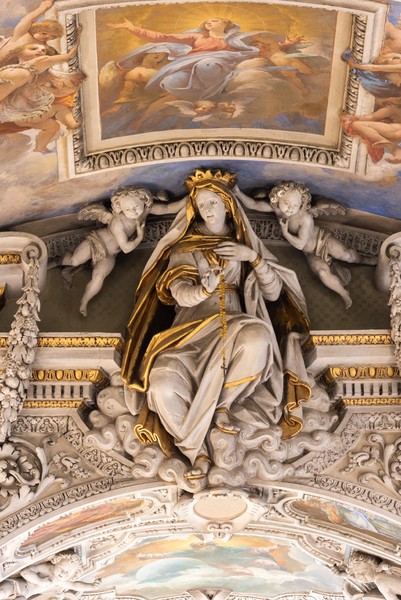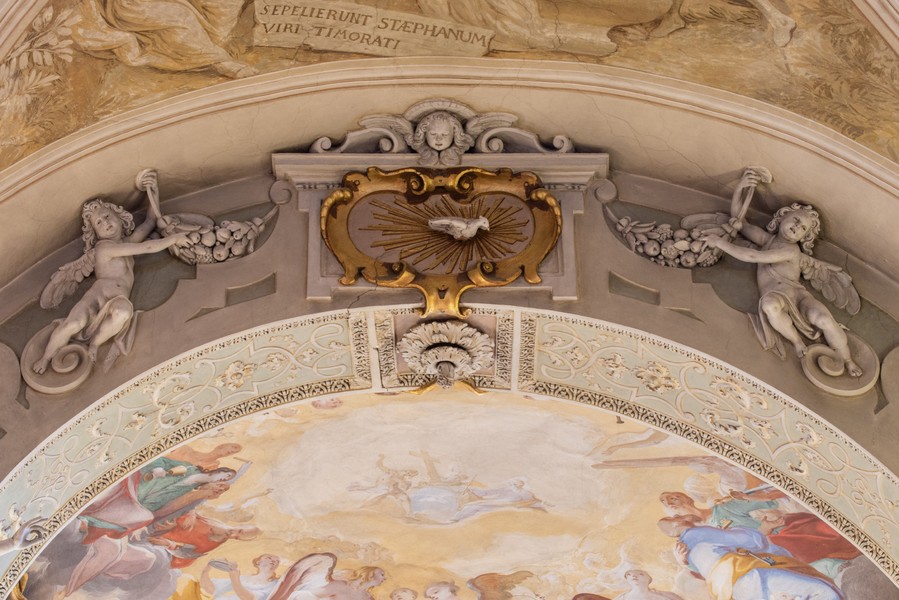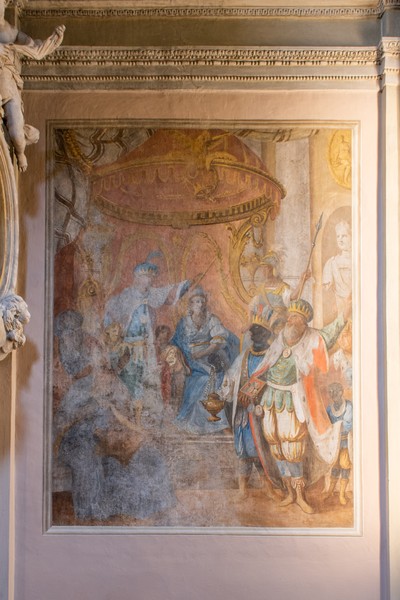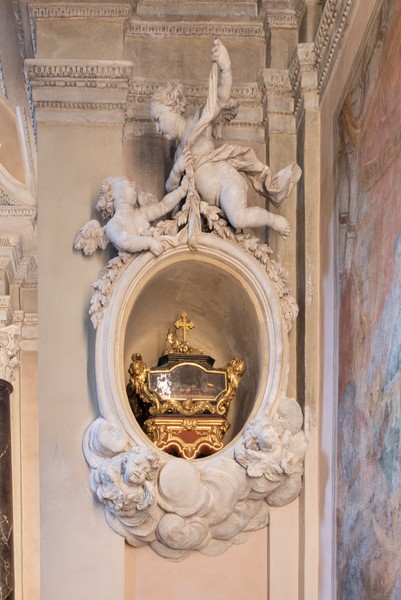CHURCH OF SANTO STEFANO
Chiesa di Santo Stefano
Stráda dala Gésa
6822 Arogno
The Church of Santo Stefano rises slightly distant from Arogno centre, situated near the parish ossuary and cemetery (Fig. 1). The current appearance results from a series of extensions subsequent to the separation of this parish from that of Riva San Vitale, in 1581. In the years following, the chapels of the Madonna of the Rosary and the Three Kings were erected, the vaulted roof was added and the baptismal font was moved to the left of the entrance portal. The transformation of the spaces in baroque style began in 1625 with the decoration of the Chapel of the Rosary (1625-1640), followed by the renovation of the choir (1639), the decoration of the Chapel of the Three Kings (1640-1645), the construction of the Chapel of St Anthony of Padua (1653-1654), and the construction of the Chapel of the Suffrage (1682-1688); the mural paintings here and on the vault of the chancel, made around 1728, are attributed to Luca Antonio Colomba (1674-1737)1. In the next century came the additions of a new high altar (pre-1838) 2 and the decoration of the apse with stuccos by Massimo Cometta of Arogno (1810-1900). The stucco work was donated, as attested in the inscription on the intrados of the apsidal arch, also indicating the date as 1839.
Over the 20th century there were several restoration interventions: in 1955-1956, concentrated on the interior; in 1991-1993, directed by architect Tita Carloni, on the façade and bell tower.
Santo Stefano was the parish of important families of artists, including the Adamo, Colomba, Artari, Cometta, Consiglio and Stella lineages. For these and other families of the region, it was a confirmed custom to honour their local churches by creating precious works for the interiors. In this regard, the painters and plasterers of the Colomba family were particularly active.
Chapel of the Rosary
This chapel, founded in 15813 by Giovanni Stella, was rebuilt and enlarged in 1625 at the behest of the Brotherhood of the Holy Rosary4, thanks to a bequest of 60 scudi designated for “li stucchi della capella … fatti dal detto Colomba” 5 (Fig. 2, 3, 4). In fact the date of completion and initials of the stuccatore, Giovanni Antonio Colomba (1585-1650) are inscribed in the stucco cartouches supported by pairs of putti, inserted beneath the cornice entablature of the side walls: at left, “I[ohannes].A[ntonius].C[olomba]./F[ecit]”; at right, “ANNO/MDCXXX” (Fig. 5, 6). The statues in the round at the foot of the triumphal arch represent two saints who were very much alive in traditional worship: St Roch (Fig. 7, 8), invoked against natural disasters and disease, and St Anthony Abbot (Fig. 9), protector of domestic animals. In both statues, the treatment of the stucco communicates impressions of severity, thanks in particular to the finish in finely crushed and highly worked marmorino, which inevitably renders an expressive hardness in the material.
On the cornice above and behind the altar are the prophets Jeremiah, Isaiah(unfortunately much altered by past restorations), David and Solomon (Fig. 10, 11). at the top of the arch is the dedicatory Madonna of the Rosary (Fig. 12).
The various sculptural figures reveal stylistic and technical differences. Looking to the top of the tympanum, for example, the character of the stuccowork in the Madonna and the two Musician Angels changes (Fig. 13). For these particular figures, the poses are more realistic, relaxed and vital; the draperies have the softness of fabric. The figures are rich in pathos and invite devotion. We do not know, however, whether this particular expressiveness is due to the direct intervention of Colomba or to special care by his employees. The angels on the altar vault, and the four putti on the side walls holding cartouches with the artist’s initials and date, also assume very natural poses: with their gaze turned towards the observer, these are very expressive and lively. On the other hand, David, Solomon, St Roch and St Anthony are all stylistically close: all have similar features and the same rigidity, almost as if carved in wood.
On the walls of this chapel, the artist has conceived and developed the decorative details in fluid and organic manner, demonstrating skill in managing space and proportions. A late mannerist flavour can be observed in the cornices and cartouches, most notably in the anthropomorphic motifs (Fig. 14).
Triumphal arch and choir
The stucco work in the choir was completed in 16406, and the artist can be assumed as the same Giovanni Antonio Colomba as for the Rosary Chapel. Looking at the stuccos elsewhere in the church, but especially with those of the Rosary Chapel, we can see very close stylistic, formal and technical similarities with all the works of the choir (Fig. 15, 16, 17): in the apostles Peter and Paul on the pilasters at the entrance (Fig. 18, 19); in the figures of the Annunciation on the triumphal arch; the four Doctors of the Church in the lunettes above the side walls (Fig. 20, 21, 22) also in the cornice of the choir and the frames of the two large wall paintings on the side walls, showing episodes from the Life of St Stephen (Fig. 23).
The two Apostles are works of great quality, dynamic in posture and meticulous in details, despite some rigidity. The precise, almost “carved” quality of the draperies communicates a Nordic stylism. The technical quality of execution is very high, noticeable especially in the details of the hands . With these works, Colomba has proven himself a master of the stucco arts.
Chapel of the Three Kings
The Chapel of the Three Kings (Fig. 24), opposite the Chapel of the Rosary and similar in size and architectural structure, was built in 16407. Little of the decoration survives: the few stuccoes, contemporary with those in the choir but heavily reintegrated during restoration works, can be attributed to the workshop of Giovanni Antonio Colomba.
The altarpiece with the Adoration of the Magi is by an unknown artist, while the paintings on the side walls (Visit of the Magi and Magi Consulting the Holy Scriptures) (Fig. 25, 26) are by Giovanni Battista Innocenzo Colomba (1717-1801), executed in 1799 “aetatis suae 82” (at age of 82). The frames of the two oval reliquaries are by the stuccatore Diego Carlone of Intelvi (1727-1728) (Fig. 27, 28, 29).

























































